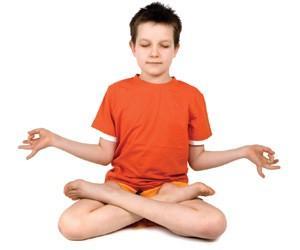Photo Gallery

Once Upon a Pose
Published: 04/15/2010 by Donna Freeman B.Ed
Everywhere those looking for a healthy lifestyle and physical workout are discovering yoga’s many benefits. Over the past few years, yoga has become increasingly popular in communities across the nation. More and more yoga studios are opening their doors and offering a wide variety of classes and styles.
At the same time, several medical studies have proven yoga to be beneficial for specific segments of the population. It’s been used successfully when working with persons suffering from depression, cancer, HIV, AIDS, and eating disorders. It has also been known to help teens in crisis and the homeless. For these reasons, yoga classes are not uncommon to find in schools and on college campuses.
Yoga has also been effective in improving the lives of students with asthma, Attention Deficit Hyperactivity Disorder (ADHD), autism, cerebral palsy and Down syndrome. Students with these conditions benefit physically, mentally and emotionally from Yoga. This ancient art, allows them to come to know themselves and their environment on a deeper, more subtle level.
Asthma
While students with asthma are encouraged to participate in physical activities many avoid it because they fear it will trigger an asthma attack. In fact, the opposite is actually true. Anaerobic movement education, such as yoga, prevents students with asthma from becoming isolated, withdrawn and physically unconditioned. All of these are circumstances which may cause or increase the severity of an asthma attack.
Yoga’s greatest benefit is teaching asthmatics how to control their mind and emotions. With increased self awareness, students with asthma begin to pinpoint possible causes for their ailment and find their own triggers.
Breathing exercises enhance air-flow, strengthen the lungs, and increase lung capacity and pulmonary efficiency. The Buteyko method (a series of nasal breathing, breath holding and relaxation) in particular has been shown to be highly effective at reducing asthmatic medication requirements.1
Relaxation techniques and meditation help reduce anxiety. This can be extremely helpful to asthmatics since stress is a major contributor to asthma attacks.2 As students learn to induce the relaxation response they reduce the nervous system’s overall activity. This stabilizes the body’s immune system and aides the body in resisting illness. Due to this yoga may lower the incidence of respiratory infections!
Attention Deficit Hyperactivity Disorder
Students with ADHD experience one primary challenge: focus. Focus issues include lack of focus, fluctuations in focus, inability to refocus, or obsessive focus. Yoga poses and breathing techniques can dramatically improve focus. Yoga practices visualization, affirmation, and relaxation all of which are especially powerful tools for attention therapy.3
Balance poses in particular help increase attention span and concentration. Studies have shown yoga “ . . .increases concentration, promotes physical discipline, and induces confidence . . . and can prove helpful to calm and soothe someone who suffers from hyperactivity.”4
As with asthmatics, yogic breathing exercises can be used with ADHD students as a calming tool. Practicing them regularly helps teach students how to regulate their emotions and take their time to respond in an appropriate manner. Once yoga techniques are learned they can be
used at anytime, empowering children to better meet their emotional and physical needs independently.
Many children with ADHD have difficulty relaxing or simply being still. Corpse Pose helps children with ADHD learn to ‘turn off’ as it induces a relaxation response. By practising yoga, children become aware of how it feels to turn their mental and physical dialogues off and enjoy quiet stillness.
Autism
Yoga helps to improve low muscle tone and poor coordination typical of autism. It is an appropriate and enjoyable physical program which develops balance, improves strength, and tones the entire body. Yoga can soothe the nervous system and allow pent-up energy to be released, which may alleviate sensitivity to sensory stimulus often exhibited through ‘stim’ behaviours (repeated uncontrollable movements).
Chanting, singing, playing drums and other forms of music therapy can also be part of the yoga experience. Music has been shown to increase engagement and interest in students with autism spectrum disorders and may even develop emotional processing in the brain.5
Breathing techniques, visualizations, and relaxation exercises help reduce stress and teach coping techniques, providing a sense of calm and acceptance. In addition, a regular well-organized yoga class offers routines and patterns which are extremely beneficial to those with autism.6
The book Yoga for Children with Autism Spectrum Disorders by Dion E. Betts, is a great place to learn how to assist autistic students using yoga. Written by parents of an autistic child, this book provides specific recommendations from hands-on experience. The authors provide solid advice and clear instructions to assist parents and caregivers of autistic students.
Cerebral Palsy
The benefits of yoga for students with cerebral palsy can be extensive. It is recommended as a holistic practice for these individuals as it works to slow the process of developing muscle contractures.7
Yoga poses specifically address the compromised posture, tight muscles, and restrictive movement characteristic of cerebral palsy. They provide a complete workout with a focus on equal development of the right, left, front, and back body. Poses can also be easily adapted to accommodate physical limitations and specific requirements. Props such as bolsters, blocks and straps are used to help with alignment and open the body deeply.
Moreover, yoga increases coordination and flexibility as the mind and body work together to execute poses. Twists, forward bends and back bends stimulate the internal organs and strengthen stomach and back muscles.
For spastic cerebral palsy relaxation exercises may reduce high muscle tone, stretch and realign the spine, and increase the space between the vertebrae. Those with athetoid cerebral palsy benefit from exercises which quiet the mind, even the breath, and increase control of the muscles. Floor yoga poses would be a good example of this type of excercise.8
Down Syndrome
Yoga works on both the physical and mental abilities of students with Down syndrome. Low muscle tone and excessive flexibility are common with this condition. Yoga provides opportunities to strengthen and tone muscles while tightening ligaments.
Standing poses are especially beneficial for unstable knee-caps, weak ankles and feet. They also stimulate physical and mental abilities through guided imagery, developing body awareness, and increasing concentration and memory.
Digestive and related issues may be alleviated by practising twists which massage internal organs and release tension in the spine. Known for their squeeze and soak action, participants compress the internal organs during the twist, then allow these areas to be bathed in oxygen rich blood upon release. This action tones the abdomen and detoxifies the body.
Music is an excellent addition to a Down syndrome yoga program. This helps to engage musical and rhythmic intelligences and builds upon the innate fondness of music in individuals with this condition.9
Breathing exercises ease pulmonary hypertension and nasal congestion, while providing a safe workout for students with the congenital heart defects often associated with Down syndrome.10
After the Mat is Put Away
While yoga is not a magic cure, it’s numerous benefits affect life on and off the mat. In addition to the long list of physical benefits it can increase self esteem, encourage positive social interactions, promote healthy sleep patterns, build connections, and teach stress management.
Visualizations and affirmations help students access internal strengths, face their demons, calm their fears, and discover who they are. Progressive muscle relaxation trains the mind, increasing body connections and awareness. Relaxation releases oxytocin (the ‘feel-good’ endorphin), and instils a sense of peace and acceptance.
There is a wonderful video of yoga and students with special needs on YouTube called “The Special Yoga Centre”. Another useful resource is the book Yoga for the Special Child: A Therapeutic Approach for Infants and Children with Down Syndrome, Cerebral Palsy, Learning Disabilities by Sonia Sumar.
As students with special needs incorporate yoga into their lives, remarkable physical, emotional, and mental benefits can result. It is not uncommon, after just one session, for students to become more aware of their body and in touch with their emotions. Maybe we all need a little Yoga in our lives! <>
- Warding off Winter Wheezing, Canadian Health Winter 2010 vol 5 no1
- Yoga for Broncial Asthma: A Controlled Study by R. Nagarathna & H.R. Nagendra, article undated
- Research Review: Attention Deficit Hyperactivity Disorder by Felicia Tomasko, January 2006
- Yoga and ADHD by Merely Me M.Ed, September 2009
- Music Strikes a Chord in the Autistic Brain, Autism Today, article undated
- The Yoga of Autism by Carla Douros, December 2006
- Developmental Medicine and Child Neurology editors Peter Baxter & Hilary Hart, October 2009
- Working with Clients Who Have Cerebral Palsy by Ruth Werner, LMP, NCTMB, August 2002
- Music and Down’s Syndrome, by Bethan Mair Pickard, dissertation Royal Welsh College of Music & Drama, spring 2009
- Yoga for the Special Child by Sonia: A Therapeutic Approach for Infants and Children with Down Syndrome, Cerebral Palsy, Learning Disabilities by Sonia Sumar, 1998


